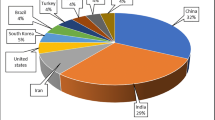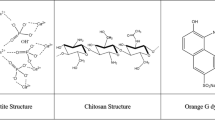Abstract
Chitosan (CS) and hydroxyapatite (HA) nanocomposites have been prepared and used for the simultaneous removal of Titan Yellow (TY) and Reactive Blue 4 (RB 4) dyes from aqueous solutions in single and binary batch systems. Chitosan@hydroxyapatite nanocomposites (NCs) were characterized by diverse techniques such as EDX, FTIR, TGA, and FESEM. Derivative spectrophotometry (DS) was developed to the determination of TY and RB 4 in two-compound mixtures employing the ‘zero-crossing’ technique. The influence of operational variables (such as sorbent mass, contact time, pH, and initial concentration of dyes) on the dyes adsorption is evaluated. A response surface methodology based on a Hybrid central composite design is used to optimize the removal of dyes by CS@HA NCs through a batch adsorption process. In optimum conditions (pH = 4, sorbent dosage = 0.03 g TY (initial TY concentration) = 1100 mg L−1 and RB 4 (initial RB 4 concentration) = 950 mg L−1), the maximum uptake capacities of dyes were obtained 170.7 and 118.4 mg g−1 for TY and RB 4 dyes, respectively. The Langmuir isotherm model was convenient for elucidating the dye adsorption process in both single and binary solutions. The adsorption kinetics of both TY and RB 4 dyes were in best correlation with pseudo 2nd order model. The thermodynamic calculations elaborated that the adsorption of TY and RB 4 dyes was endothermic and spontaneous.
Graphic Abstract









Similar content being viewed by others
References
Jin L, Sun Q, Xu Q, Xu Y (2015) Adsorptive removal of anionic dyes from aqueous solutions using microgel based on nanocellulose and polyvinylamine. Bioresour Technol 197:348–355
Yagub MT, Sen TK, Afroze S, Ang HM (2014) Dye and its removal from aqueous solution by adsorption: a review. Adv Colloid Interface Sci 209:172–184
Ghaemi M, Absalan G, Sheikhian L (2014) Adsorption characteristics of Titan yellow and Congo red on CoFe2O4 magnetic nanoparticles. J Iran Chem Soc 11:1759–1766
Chaudhari AU, Paul D, Dhotre D, Kodam KM (2017) Effective biotransformation and detoxification of anthraquinone dye reactive blue 4 by using aerobic bacterial granules. Water Res 122:603–613
Akrami A, Niazi A (2016) Synthesis of maghemite nanoparticles and its application for removal of Titan yellow from aqueous solutions using full factorial design. Desalin Water Treat 57:22618–22631
Kyzas GZ, Matis KA (2015) Nanoadsorbents for pollutants removal: a review. J Mol Liq 203:159–168
Carolin CF, Kumar PS, Saravanan A et al (2017) Efficient techniques for the removal of toxic heavy metals from aquatic environment: a review. J Environ Chem Eng 5:2782–2799
Karimi MH, Mahdavinia GR, Massoumi B et al (2018) Ionically crosslinked magnetic chitosan/κ-carrageenan bioadsorbents for removal of anionic eriochrome black-T. Int J Biol Macromol 113:361–375
Fat’hi MR, Nasab SJH (2018) Synthesis of calcon-imprinted magnetic chitosan nanoparticles as a novel adsorbent and its application in selective removal of calcon dye from aqueous solutions. Int J Biol Macromol 114:1151–1160
Salah TA, Mohammad AM, Hassan MA, El-Anadouli BE (2014) Development of nano-hydroxyapatite/chitosan composite for cadmium ions removal in wastewater treatment. J Taiwan Inst Chem Eng 45:1571–1577
Chiou M-S, Ho P-Y, Li H-Y (2004) Adsorption of anionic dyes in acid solutions using chemically cross-linked chitosan beads. Dye Pigment 60:69–84
Sutirman ZA, Sanagi MM, Karim KJA et al (2018) Equilibrium, kinetic and mechanism studies of Cu (II) and Cd (II) ions adsorption by modified chitosan beads. Int J Biol Macromol 116:255–263
Aliabadi M, Irani M, Ismaeili J, Najafzadeh S (2014) Design and evaluation of chitosan/hydroxyapatite composite nanofiber membrane for the removal of heavy metal ions from aqueous solution. J Taiwan Inst Chem Eng 45:518–526
Jang SH, Jeong YG, Min BG et al (2008) Preparation and lead ion removal property of hydroxyapatite/polyacrylamide composite hydrogels. J Hazard Mater 159:294–299
Cui W, Hu Q, Wu J et al (2008) Preparation and characterization of magnetite/hydroxyapatite/chitosan nanocomposite by in situ compositing method. J Appl Polym Sci 109:2081–2088
Zolgharnein J, Choghaei Z, Bagtash M et al (2016) Nano-Fe3O4 and corn cover composite for removal of Alizarin Red S from aqueous solution: characterization and optimization investigations. Desalin Water Treat 57:27672–27685
Zolgharnein J, Shahmoradi A, Sangi MR (2008) Optimization of Pb (II) biosorption by Robinia tree leaves using statistical design of experiments. Talanta 76:528–532
Mäkelä M (2017) Experimental design and response surface methodology in energy applications: a tutorial review. Energ Convers Manag 151:630–640
Abbasi M, Habibi MM (2016) Optimization and characterization of Direct Blue 71 removal using nanocomposite of Chitosan-MWCNTs: central composite design modeling. J Taiwan Inst Chem Eng 62:112–121
Janaki V, Vijayaraghavan K, Ramasamy AK et al (2012) Competitive adsorption of Reactive Orange 16 and Reactive Brilliant Blue R on polyaniline/bacterial extracellular polysaccharides composite—a novel eco-friendly polymer. J Hazard Mater 241:110–117
Zolgharnein J, Rastgordani M (2018) Optimization of simultaneous removal of binary mixture of indigo carmine and methyl orange dyes by cobalt hydroxide nano-particles through Taguchi method. J Mol Liq 262:405–414
Gao J-F, Wang J-H, Yang C et al (2011) Binary biosorption of Acid Red 14 and Reactive Red 15 onto acid treated okara: simultaneous spectrophotometric determination of two dyes using partial least squares regression. Chem Eng J 171:967–975
Bagtash M, Zolgharnein J (2018) Hybrid central composite design for simultaneous optimization of removal of methylene blue and alizarin red S from aqueous solutions using Vitis tree leaves. J Chemom 32:e2960
Turabik M (2008) Adsorption of basic dyes from single and binary component systems onto bentonite: simultaneous analysis of Basic Red 46 and Basic Yellow 28 by first order derivative spectrophotometric analysis method. J Hazard Mater 158:52–64
Karpińska J (2004) Derivative spectrophotometry—recent applications and directions of developments. Talanta 64:801–822
Andronic L, Duta A (2012) Photodegradation processes in two-dyes systems—simultaneous analysis by first-order spectra derivative method. Chem Eng J 198:468–475
Bezerra MA, Santelli RE, Oliveira EP et al (2008) Response surface methodology (RSM) as a tool for optimization in analytical chemistry. Talanta 76:965–977
Zolgharnein J, Rastgordani M (2018) Multivariate optimization and characterization of simultaneous removal of binary mixture of Cu(II) and Pb(II) using Fe3O4@MoS2 nanoparticles. J Chemom 32:e3043
Zolgharnein J, Dalvand K, Rastgordani M, Zolgharnein P (2017) Adsorptive removal of phosphate using nano cobalt hydroxide as a sorbent from aqueous solution; multivariate optimization and adsorption characterization. J Alloys Compd 725:1006–1017
Zolgharnein J, Shahmoradi A (2010) Characterization of sorption isotherms, kinetic models, and multivariate approach for optimization of Hg (II) adsorption onto Fraxinus tree leaves. J Chem Eng Data 55:5040–5049
Montgomery DC (2017) Design and analysis of experiments. John Wiley and Sons, New York
Roquemore KG (1976) Hybrid designs for quadratic response surfaces. Technometrics 18:419–423
Zolgharnein J, Bagtash M (2015) Hybrid central composite design optimization for removal of methylene blue by Acer tree leaves: characterization of adsorption. Desalin Water Treat 54:2601–2610
Hibbert DB (2012) Experimental design in chromatography: a tutorial review. J Chromatogr B 910:2–13
Gao J-F, Zhang Q, Su K, Wang J-H (2010) Competitive biosorption of Yellow 2G and Reactive Brilliant Red K-2G onto inactive aerobic granules: Simultaneous determination of two dyes by first-order derivative spectrophotometry and isotherm studies. Bioresour Technol 101:5793–5801
Zolgharnein J, Bagtash M, Shariatmanesh T (2015) Simultaneous removal of binary mixture of Brilliant Green and Crystal Violet using derivative spectrophotometric determination, multivariate optimization and adsorption characterization of dyes on surfactant modified nano-γ-alumina. Spectrochim Acta Part A Mol Biomol Spectrosc 137:1016–1028
Bekçi Z, Özveri C, Seki Y, Yurdakoç K (2008) Sorption of malachite green on chitosan bead. J Hazard Mater 154:254–261
Adeogun AI, Ofudje EA, Idowu MA et al (2018) Biowaste-derived hydroxyapatite for effective removal of reactive yellow 4 dye: equilibrium, kinetic, and thermodynamic studies. ACS Omega 3:1991–2000
Singh KP, Gupta S, Singh AK, Sinha S (2011) Optimizing adsorption of crystal violet dye from water by magnetic nanocomposite using response surface modeling approach. J Hazard Mater 186:1462–1473
Samuel MS, Chidambaram R (2015) Hexavalent chromium biosorption studies using Penicillium griseofulvum MSR1 a novel isolate from tannery effluent site: Box–Behnken optimization, equilibrium, kinetics and thermodynamic studies. J Taiwan Inst Chem Eng 49:156–164
Zolgharnein J, Asanjarani N, Shariatmanesh T (2013) Taguchi L 16 orthogonal array optimization for Cd (II) removal using Carpinus betulus tree leaves: adsorption characterization. Int Biodeterior Biodegrad 85:66–77
Kannusamy P, Sivalingam T (2013) Synthesis of porous chitosan–polyaniline/ZnO hybrid composite and application for removal of reactive orange 16 dye. Coll Surf B Biointerfaces 108:229–238
Debnath S, Ballav N, Maity A, Pillay K (2017) Competitive adsorption of ternary dye mixture using pine cone powder modified with β-cyclodextrin. J Mol Liq 225:679–688
Karthik R, Meenakshi S (2015) Removal of Cr (VI) ions by adsorption onto sodium alginate-polyaniline nanofibers. Int J Biol Macromol 72:711–717
Zolgharnein J, Bagtash M, Asanjarani N (2014) Hybrid central composite design approach for simultaneous optimization of removal of alizarin red S and indigo carmine dyes using cetyltrimethylammonium bromide-modified TiO2 nanoparticles. J Environ Chem Eng 2:988–1000
Zolgharnein J, Asanjrani N, Bagtash M, Azimi G (2014) Multi-response optimization using Taguchi design and principle component analysis for removing binary mixture of alizarin red and alizarin yellow from aqueous solution by nano γ-alumina. Spectrochim Acta Part A Mol Biomol Spectrosc 126:291–300
Fard GC, Mirjalili M, Najafi F (2017) Hydroxylated α-Fe2O3 nanofiber: optimization of synthesis conditions, anionic dyes adsorption kinetic, isotherm and error analysis. J Taiwan Inst Chem Eng 70:188–199
Bagtash M, Zolgharnein J (2018) Removal of brilliant green and malachite green from aqueous solution by a viable magnetic polymeric nanocomposite: simultaneous spectrophotometric determination of 2 dyes by PLS using original and first derivative spectra. J Chemom 32:e3014
He Y, Zhang L, An X, Wan G et al (2019) Enhanced fluoride removal from water by rare earth (La and Ce) modified alumina: adsorption isotherms, kinetics, thermodynamics and mechanism. Sci Total Environ 688:184–198
Noroozi B, Sorial GA (2013) Applicable models for multi-component adsorption of dyes: a review. J Environ Sci 25:419–429
Foo KY, Hameed BH (2010) Insights into the modeling of adsorption isotherm systems. Chem Eng J 156:2–10
Rangabhashiyam S, Anu N, Nandagopal MSG, Selvaraju N (2014) Relevance of isotherm models in biosorption of pollutants by agricultural byproducts. J Environ Chem Eng 2:398–414
Zolgharnein J, Bagtash M, Feshki S et al (2017) Crossed mixture process design optimization and adsorption characterization of multi-metal (Cu (II), Zn (II) and Ni (II)) removal by modified Buxus sempervirens tree leaves. J Taiwan Inst Chem Eng 78:104–117
Saberi A, Sadeghi M, Alipour E (2020) Design of AgNPs-Base starch/PEG-poly (acrylic acid) hydrogel for removal of mercury (II). J Polym Environ 28:906–917
Senthil Kumar P, Ramalingam S, Senthamarai C et al (2010) Adsorption of dye from aqueous solution by cashew nut shell: studies of equilibrium isotherm, kinetics and thermodynamics of interactions. Desalination 261:52–60
Errais E, Duplay J, Darragi F et al (2011) Efficient anionic dye adsorption on natural untreated clay: kinetic study and thermodynamic parameters. Desalination 275:74–81
Author information
Authors and Affiliations
Corresponding author
Additional information
Publisher's Note
Springer Nature remains neutral with regard to jurisdictional claims in published maps and institutional affiliations.
Rights and permissions
About this article
Cite this article
Rastgordani, M., Zolgharnein, J. Simultaneous Determination and Optimization of Titan Yellow and Reactive Blue 4 Dyes Removal Using Chitosan@hydroxyapatite Nanocomposites. J Polym Environ 29, 1789–1807 (2021). https://doi.org/10.1007/s10924-020-01982-7
Accepted:
Published:
Issue Date:
DOI: https://doi.org/10.1007/s10924-020-01982-7




